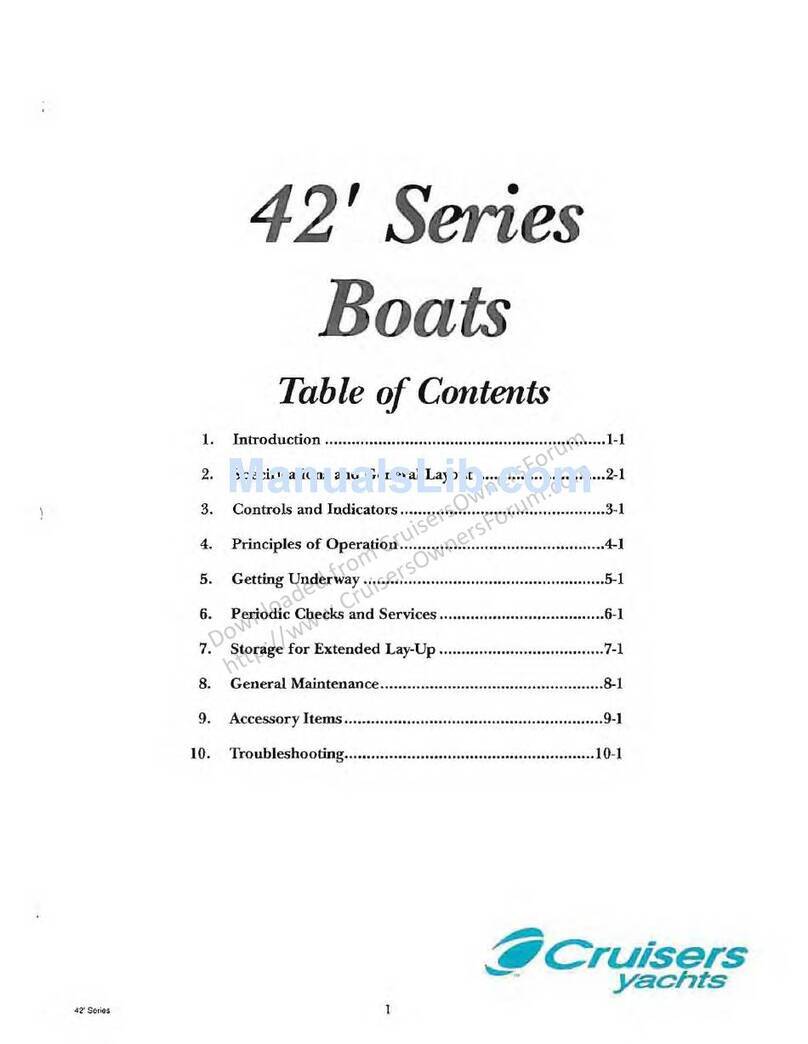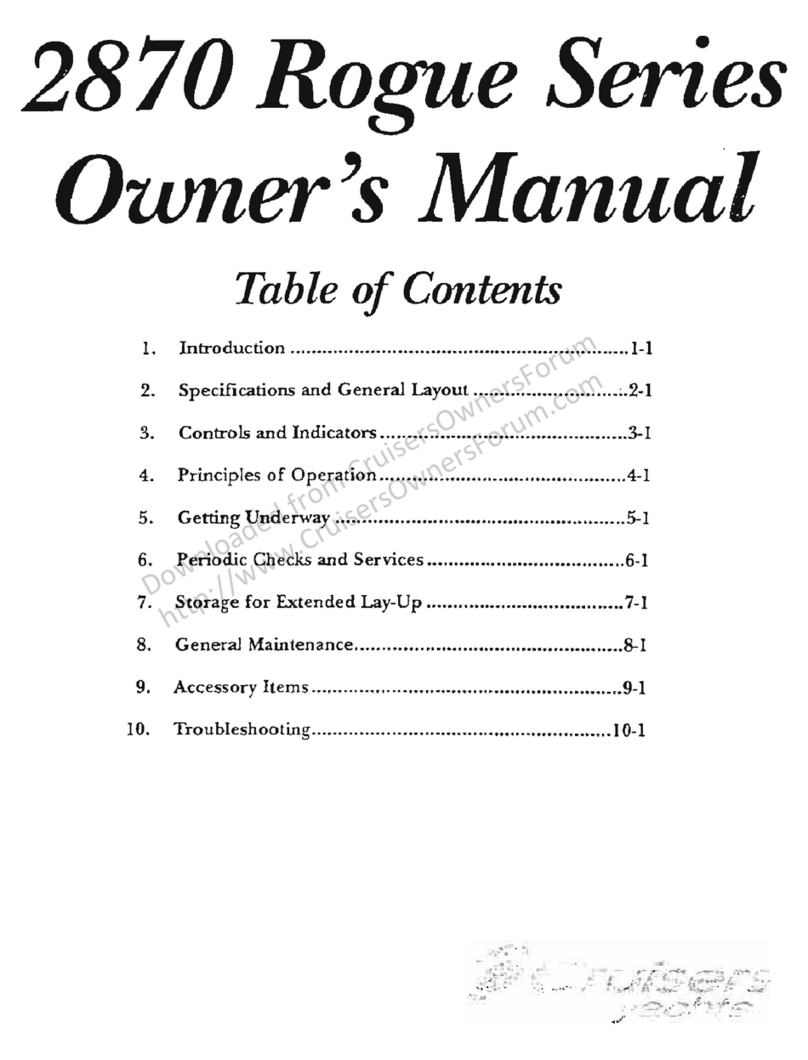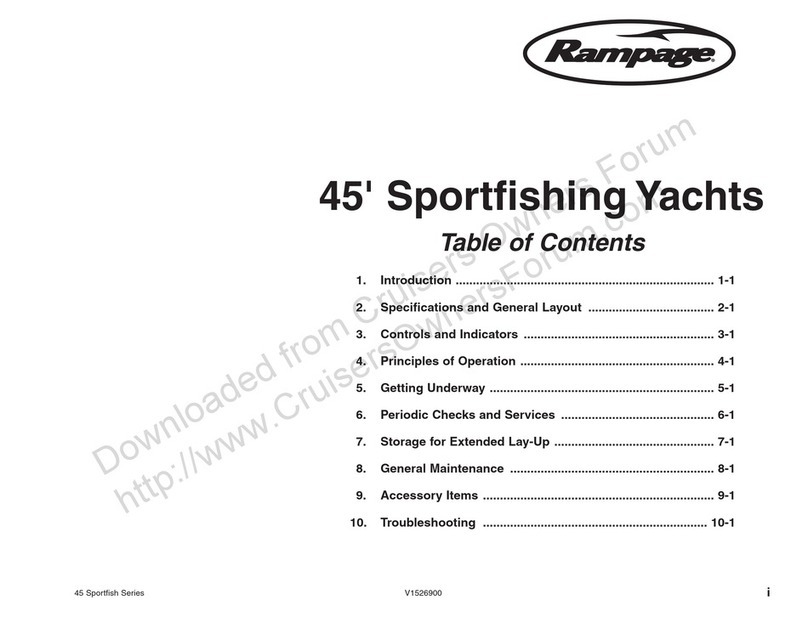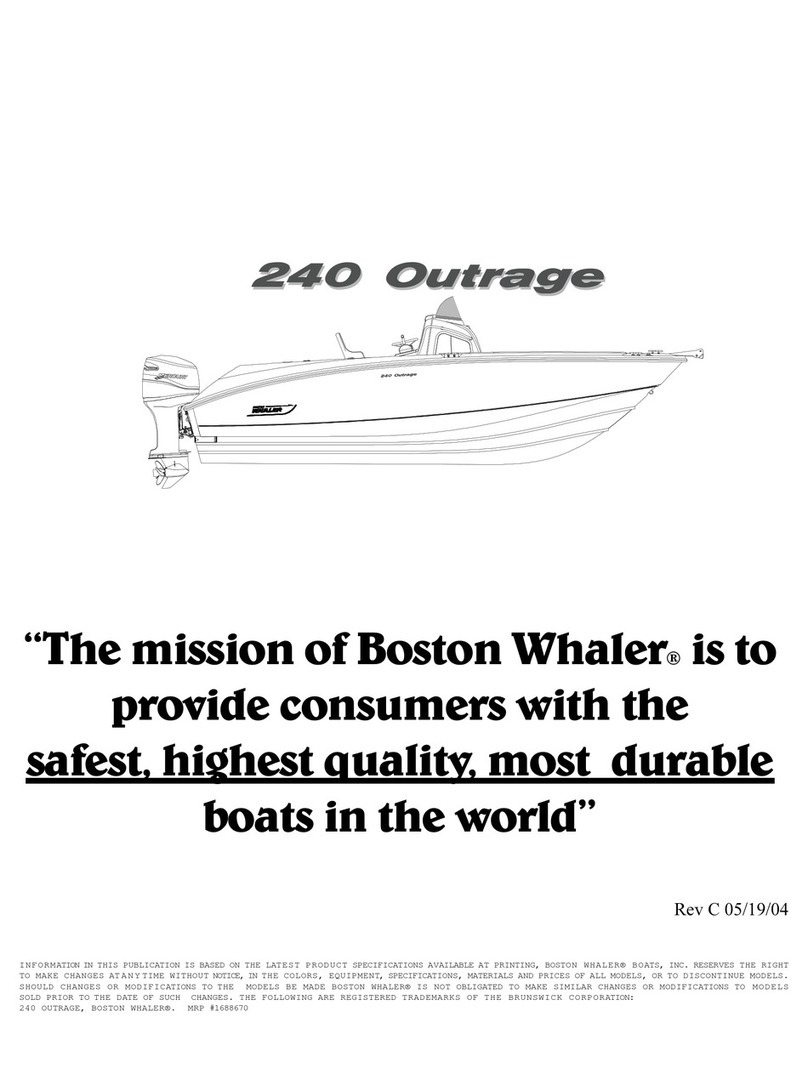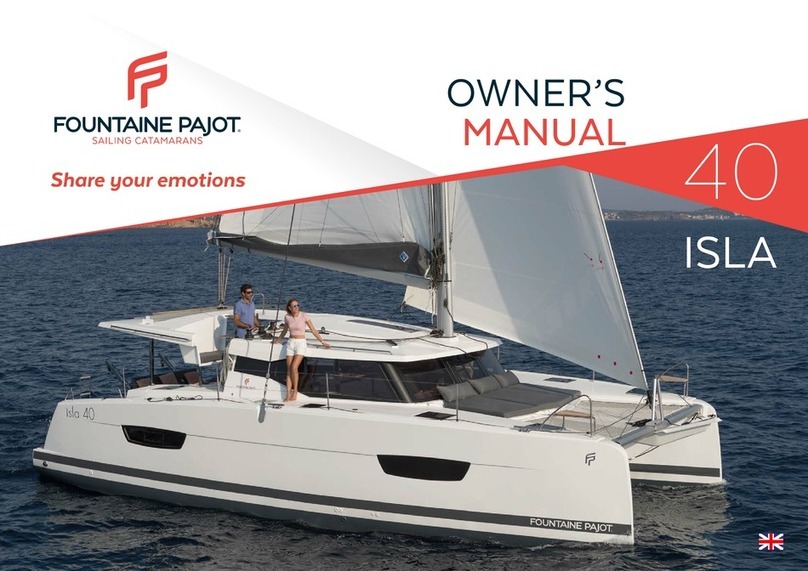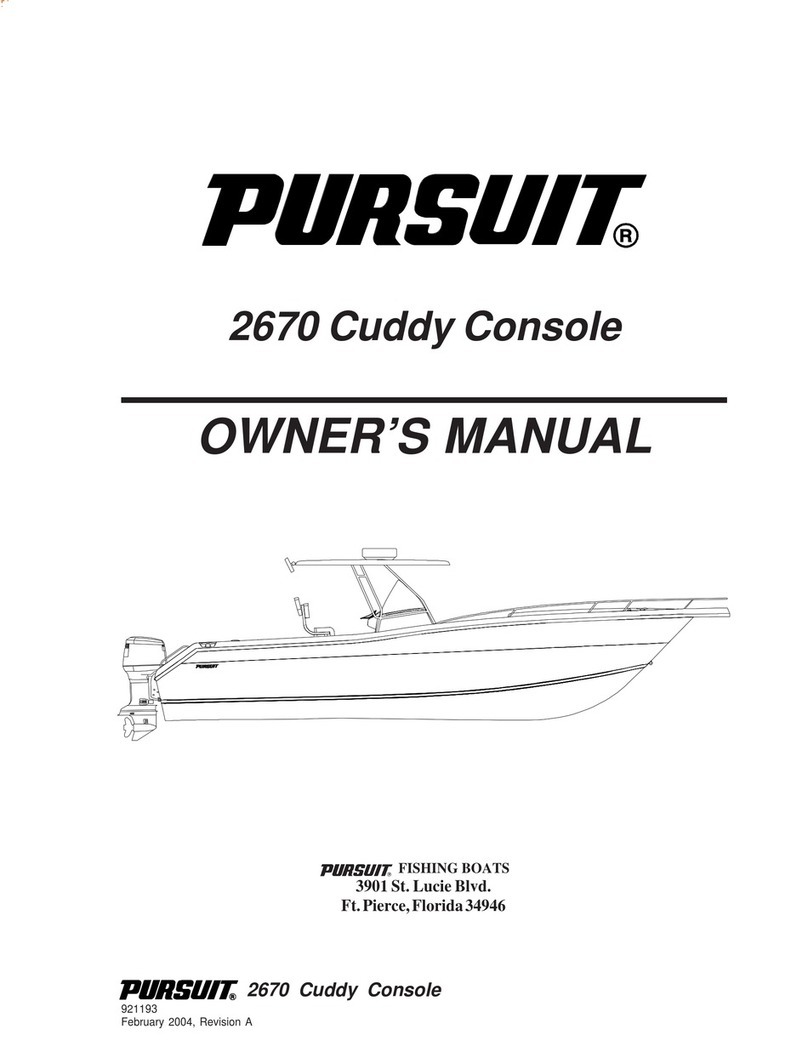M.E.S. Marine Europa Sport User manual

1
OWNER’S MANUAL
Compiled in accord to EN ISO 6185-3:2004 and RSG guidelines
M.E.S. Marine Limited
Zone 1, Unit 64, Deeside Industrial Park, Welsh Road,
Deeside, Flintshire, CH5 2LR.
Tel: 01244 289977
www.europa-sport.co.uk
M.E.S. Marine Limited reserves the right to change, alter, and modify their finished boats, parts, and specifications without notice.
Optional equipment may vary from model to model and year to year. Please consult with your dealer for current information on standard
and optional equipment and specifications.
Revised September 2013

2
INDEX
Page 3-4 Introduction
Page 5 Design categories
Page 6 Degree of danger and hazard labels
Page 7 Engine and propulsion unit
Page 9 Electrical system
Page 10 LPG system
Page 11-14 Risks of fire
Page 15 Flooding and buoyancy information
Page 16 Navigation
Page 17-19 Other recommendations
Page 20 Occasional operations
Page 21-23 Regular inspections, Maintenance, Environment, Inflatable
boats
Page 24 Identification
Page 25 Stability information
Page 26 Specific information

3
INTRODUCTION
Thanks for your choice.
This manual has been compiled to help you to operate your craft with
safety and pleasure.
It contains details of the craft, the equipment supplied or fitted, its
systems, and information on their operation.
Please read it carefully, and familiarize yourself with the craft before
using it.
This owner's manual is not a course on boating safety or seamanship.
If this is your first craft, or you are changing to a type of craft you are not
familiar with, for your own comfort and safety, please ensure that you obtain
handling and operating experience before "assuming command" of the craft.
Your dealer or national sailing federation or yacht club will be pleased to
advise you of local sea schools, or competent instructors.
Ensure that the anticipated wind and sea conditions will correspond to
the design category of your boat, and that you and your crew are able to
handle the boat in these conditions.
Even when your boat is categorised for them, the sea and wind
conditions corresponding to the design categories A, B, and C range from
severe storm conditions for category A, to strog conditions for the top of
category C, open to the hazards of a freak wave or gust.
These are therefore dangerous conditions, where only a competent, fit
and trained crew using a well maintained boat can satisfactorily operate.
This owner's manual is not a detailed maintenance or trouble shooting
guide. In case of difficulty, refer to the boatbuilder or its representative.
Always use trained and competent people for maintenance, fixing or
modifications.
Modifications that may affect the safety characteristics of the craft shall
be assessed, executed and documented by competent people.
The boat builder cannot be held responsible for modifications he has not
approved.

4
In some countries a driving licence or authorisation are required, or
specific regulations are in force.
Always maintain your craft properly and make allowance for the
deterioration that will occur in time and as a result of heavy use or misuse of
the craft.
Any craft, no matter how strong it may be, can be severely damaged if
not used properly.
This is not compatible with safe boating.
Always adjust the speed and direction of the craft to sea conditions.
If your craft is fitted with a liferaft, read carefully its operating manual.
The craft should have onboard the appropriate safety equipment
(lifejacket, harness, etc.) according to the type of craft, weather conditions,
etc.
The equipment is mandatory in some countries.
The crew should be familiar with the use of all safety equipment and
emergency manoeuvring (man overboard recovery, towing, etc), sailing
schools and clubs regularly organise drill sessions.
All persons should wear a suitable buoyancy aid (life jacket/personal
flotation device) when on deck.
Note that, in some countries, it is a legal requirement to wear a buoyancy
aid that complies with their national regulations at all times.
PLEASE KEEP THIS MANUAL IN A SECURE PLACE, TOGHETER WITH
OTHER EQUIPMENT MANUALS, AND HAND IT OVER TO THE NEW
OWNER WHEN YOU SELL THE CRAFT.

5
DESIGN CATEGORIES
Category A: Ocean
A boat given design category A is considered to be designed to operate
in winds up to where conditions may exceed wind force 8 (Beaufort scale)
and significant wave heights of 4 m and above, and vessels largely self-
sufficient. Abnormal conditions such as hurricanes are excluded. Such
conditions may be encountered on extended voyages, for example across
oceans, or inshore when unsheltered from the wind and waves for several
hundred nautical miles.
Category B: Offshore
A boat given design category B is considered to be designed to operate
in winds up to Beaufort force 8 and the associated wave heights (Significant
wave height up to 4 m, see note below). Such conditions may be
encountered on offshore voyages of sufficient length or on coastal waters
when unsheltered from the wind and waves for several dozens of nautical
miles. These conditions may also be experienced on inlandseas of sufficient
size for the wave height to be generated.
Category C: Inshore
A boat given design category C is considered to be designed to operate
in winds up to Beaufort force 6 and the associated wave heights (Significant
wave height up to 2 m, see note below). Such conditions may be
encountered on exposed inland waters, in estuaries, and in coastal waters in
moderate weather conditions.
Category D: Sheltered waters
A boat given design category D is considered to be designed to operate
in winds up to Beaufort force 4 and the associated wave heights (Occasional
waves of 0,5 m height). Such conditions may be encountered on sheltered
inland waters, and in coastal waters in fine weather.
(D) The significant wave height is the mean height of the highest one
third of the waves, which approximately corresponds to the wave height
estimated by an experienced observer.
SOME WAVES WILL BE DOUBLE THIS HEIGHT

6
DEGREE OF DANGER AND HAZARD LABELS
The following abbreviations have been used:
(D); Danger (W); Warning (C); Caution
DANGER denotes an extreme intrinsic hazard exists which would result
in high probability of death or irreparable injury if proper precautions are not
taken.
WARNING denotes a hazard exists which can result in injury or death if
proper precautions are not taken.
CAUTION denotes a reminder of safety practices or directs attention to
unsafe practices which could result in personal injury or damage to the craft
or components.
The following abbreviations have been used too:
(OK); All right (NO); Wrong (NOTE); Note
The (OK) abbreviation means that the used procedure or the behaviour
adopted is in compliance with the prescription.
The (NO) abbreviation means that the used procedure or the behaviour
adopted is in compliance with the prescription and may seriously damage the
material or the ambient.
The (NOTE) abbreviation supplies important indications.

7
ENGINE AND PROPULSION UNIT
DO NOT INSTALL OR USE THIS BOAT WITH AN ENGINE POWER
GREATER OF THAT MEASURED ACCORDING TO ISO 8665 AND
SUITABLE ON THE BUILDER’S PLATE AND IN THIS MANUAL (D)
EVERY CONTACT WITH PROPELLER AND AXIS IN MOTION
OR WITH THE ROTARY PARTS OF THE ENGINE IS MOST DANGEROUS
DO NOT APPROACH (D)
Refer to the manual of the engine for operation, maintenance and winter
storage, and:
- respect the percentage of oil in the fuel (C), if is an outboard engine
- check the state of the filters periodically and after a restocking with fuel
of uncertain origin (C), if is an inboard or stern drive engine
for all engines:
- be sure you have enough fuel for your boating trip (W);
- avoid making noise and wake in the vicinity of other users, and respect
the speed limitations (W).
a) Maximum power: the authorized maximum power indicated in the builder’s
plate and in this manual must be used with the maximum precaution, from
expert customers, when they use the unit in very hard conditions (heavy duty,
etc). We suggest to you therefore to choose the power of the motor in
function of the main use that you will make of the boat and refer to the
advised power that is, in kind, 75% of that principle. With a too much powerful
motor the unit risks to being difficult to pilot. Insufficiently motorized it risks
instead not possessing a sufficient safety margin in order to gain wind and
currents.
b) Weight: the weight of the motor has great incidence on planning
characteristics, the stability and the performances of the boat. To equal
power we advise You to choose the lighter motor: a various weight from that
advising can determine sensitive variations of order.
c) Length of outboard motor’s shaft: if an outboard motor is aboard control if the
shaft is long or short and if it is adapted to Your boat: it will not be possible to
mount it if it is not adapted.
d) Propeller: for the choice of the propeller that adapted more to Your type of
employment, the boat and the motor must be tried in water. Ask the
attendance for Yours agent. The propeller supplied with the motor is lend in a
generalized manner for every type of navigation, however in function of the
main use that you preview to make with Your boat you choose:
- a short pitch when the unit needs a strong push in order to plane soon (boat
heavy loaded, nautical ski, etc.);
- a long pitch will increase speed characteristics (if the unit is light loaded)

8
Carbon Monoxide
Carbon monoxide accumulation is affected by vessel geometry; hatch,
window and door openings; ventilation openings; proximity to other
structures; wind direction; vessel speed; and a multitude of other variables.
Dangerous levels of carbon monoxide can also accumulate around the
outside of the boat when the engine or generator is running. Do not run the
engine or generator when anyone is in the water around your boat, or is
located near the exhaust outlets.
NOTE: Boats fueled by diesel have limited carbon monoxide present in the
exhaust in comparison to gasoline engine exhaust. However, the boat owner
should still be aware of the causes and effect of carbon monoxide which may
occur in different boating situations.
Warning: Carbon monoxide (CO) can be harmful or fatal if inhaled. Brain
damage or death can occur if exposed to carbon monoxide. Keep exhaust
outlets clear of blockage. Provide adequate ventilation. Open hatches, doors,
windows and vents to insure adequate ventilation. Close engine compartment
doors and hatches when engine or generator is running. Avoid operating the
boat for extended periods of time at idle speed and be sensitive to weather
conditions that may prevent CO from dissipating into the air.

9
ELECTRICAL SYSTEM
locate the position on board of the electrical devices and learn the
modality of use by their owner’s manuals (D);
locate the position and functions of electrical controls, dials, switches,
fuses and also circuit-breakers installed on panel-board or over (D)
never (D):
a) work on electrical installation while the system is energized
b) modify the craft’s electrical system or relevant drawings: installation,
alterations and maintenance should be performed by a competent
marine electrical technician;
c) alter or modify the rated current amperage of overcurrent protective
devices;
d) install or replace electrical appliances or devices with components
exceeding the rated current amperage of the circuit;
e) leave the craft unattended with the electrical system energized, except
automatic bilge-pump, fire protection and alarm circuits.
And more, if an alternating current electric system is installed in this craft (D):
f) inspect the system at least biennially;
g) disconnect shore-power connections when the system is not in use;
h) connect metallic housings or enclosures of installed electrical
appliances to the protective conductor system in the craft (green or
green with a yellow stripe conductor);
i) use double insulate or grounded (earthed) electrical appliances;
j) if the reverse polarity indicator is activated, do not use the electrical
system; correct the polarity fault before activating the electrical system
on the craft (if a polarized system with polarity indicator is aboard);
k) do not allow the shore-power cable end to hang in the water: an
electrical field can be caused which can cause injury or death to nearby
swimmers;
l) to minimize shock and fire hazards:
- turn off craft’s shore-power connection switch before connecting or
disconnecting shore-power cable
- disconnect shore power cable to craft’s inlet before connecting to
shore-power source (not required for permanently connected shore-
power cable instalIations)
- disconnect shore-power cable at shore-power source first
- if reverse polarity indicator is activated (only if a reverse polarity
indicator is required in the system), disconnect cable immediateIy
- close shore-power inlet cover tightly.
m) do not alter shore-power cable connectors, use only compatible
connectors.

10
LPG SYSTEM
If an LPG system is installed in this craft you must (D):
1) Close fuel supply-line valves and cylinder valves when appliances are not
in use. Close valves before refueling and immediately in an emergency.
2) Be sure that appliance valves are closed before opening the cylinder valve.
3) Test the LPG system for leakage regularly. Check all connections for
leakage by
- routine observation ob the bubble-leak detector (if fitted with a detector),
- observation of the pressure gauge for pressure drop with appliance valves
closed and cylinder valve opened, then closed (if bitted with gauge on supply
pressure side),
- manual leak testing, or testing with soapy water or detergent solution (with
appliance-burner valves closed and cylinder and system valves open).
If leakage is present, dose the cylinder valve and have the system
repaired before further use. System repairs should be made by a competent
person.
4) Never use solutions containing ammonia.
5) Never use flame to check for leaks.
6) Remember that fuel-burning open-flame appliances consume cabin
oxygen and release products of combustion into the craft. Ventilation Is
required when appliances are in use. Open designated vent openings while
appliances are in use. Do not use the stove or oven for space heating. Never
obstruct ventilation openings.
7) Follow all the information in order to prevent risks of fire explained in this
manual.
8) Never obstruct access to LPG system components in any way.
9) Keep valves on empty cylinders closed and disconnected. Keep protective
covers, caps or plugs in place. Store reserve cylinders in ventilated housings
on open decks or in gastight lockers which are vented overboard and
intended for that purpose.
10) Store gas cylinders only in the designed locker or housing and never use
LPG cylinder housings or cylinder lockers for storage of any other equipment.
11) Never leave craft unattended when LPG consuming appliances are in
use.
12) Never smoke or use open flame when replacing LPG cylinders.
13) Inspect hoses in LPG system regularly, and replaced if any deterioration
is found.
14) Inspect fuel pipes at least annually. Replace if deterioration or openings
are found.
15) Never use the stove when high angle of rolling or sustained angles of
heel are likely (if the craft is not equipped with a gimbaled stove).

11
RISKS OF FIRE
BOAT OWNER/OPERATOR HAS THE RESPONSIBILITY TO OBSERVATE
THIS FOLLOWING INSTRUCTIONS
Instructions for the correct execution of the following operations
related to the safety of the engine system (D):
THE LEAST TIME OF ENGINE ROOM’S VENTILATION IS: 10 MINUTES
Is advisable to verify the openings and ducts of ventilation and the
correct flow of cooling water to prevent overheating and avoid to stow
combustible materials into engine space;
put the maximum attention during the combustible filling operations:
never smoke while handling fuel or gas;
in order to prevent damages to the fuel system be careful to any
accidental contact with warm parts of the engine.
- Outboard engine: fill the portable tank outside the craft, in a well--
ventilated area, away from any risk of ignition.
- Inboard engine: ventilate engine room also opening the cover in case of
a long stop.
Instructions for the correct execution of the following operations
related to the safety of the electric system (D):
locate the position of the interrupters, know their functioning and the
operations of substitution of valves and fuses;
ventilate the batteries room and adopt any precaution during the
recharge;
adopt precautions in the phases of attack and detach to the earth of
electrical system (if present).
Instructions for the correct execution of the following operations
related to the safety of the gas system of the kitchen on board and
employment of the gas devices (D):
Do not fit free-hanging curtains or other fabrics in the vicinity of, or above
cookers or other open-flame devices;
locate the gas cylinder stowage as indicate and learn the modality of use
by his owner’s manual and pay attention during their substitution;
in case of losses of gas ventilate the rooms with precautions to prevent
contacts with flames or warm parts;
Instructions for the correct execution of fire protection fittings (D):
locate the fireproof devices (extinguishers, fixed plant etc.) and learn
their functioning by their owner’s manual;
control capacity and the request features according to actual laws and
verify their efficiency periodically;
locate the position on board of hatches, doors or other openings that are
indicate as means of escape in case of fire: cure to avoid to obstruct them.

12
Cautionary notices to the boat operator
General
Keep the bilges clean and check for fuel and gas vapours or fuel leaks
frequently.
When replacing parts of the fire-fighting installation, only matching
components shall be used, bearing the same designation or having
equivalent technical and fire-resistant capabilities.
Do not fit free-hanging curtains or other fabrics in the vicinity of, or
above, cookers or other open-flame devices.
Do not stow combustible material in the engine space. If non-
combustible materials are stowed in the engine space, they shall be secured
against falling into machinery and shall cause no obstruction to access into or
from the space.
Exits other than the main companionway doors or hatches with
permanently fixed ladders are identified by a symbol (see Table).
Specific warnings Never
- obstruct passageways to exits and hatches,
- obstruct safety controls, e.g. fuel valves, gas valves, switches of the
electrical system,
- obstruct portable fire extinguishers stowed in lockers,
- leave the craft unattended when cooking and/or heating appliances
are in use,
- modify any of the craft's systems (especially electrical, fuel and gas)
or allow unqualified personnel to modify any of the craft’s systems,
- fill any fuel tank or replace gas bottles when machinery is running, or
when cooking or heating appliances are in use,
- smoke while handling fuel or gas.
NOTE Servicing of fire-fighting equipment
The boat owner/operator shall
- have fire-fighting equipment checked at the intervals indicated on the
equipment,
- replace portable fire extinguishers, if expired or discharged, by devices of
identical fire-fighting capacity, and
- have fixed systems refilled or replaced when expired or discharged.
Responsibility of boat owner/operator
It is the responsibility of the boat owner/operator
a) to ensure that fire-fighting equipment is readily accessible when the boat is
occupied, and
b) to inform members of the crew about
the location and operation of fire-fighting equipment,
the location of discharge openings into the engine space, and
the location of routes and exits.
Displayed warning notices

13
The following warning notices are displayed in the craft in the form of
labels selected by the boat manufacturer shall select from the following
selection. The same also where a space which is regarded as being sealed is
protected by a fixed system, the following information is displayed near the
release device.
Where a space, which is protected by a fixed system, cannot be
regarded as being sealed from adjacent accommodation, the following
information shall is displayed near the release device.
The following information is displayed at any entrance to the protected
space(s), if the extinguishing medium is an asphyxiant.
The following information is displayed near any CO2 portable extinguisher:
The following symbols are displayed in the small craft where appropriate.

14

15
FLOODING AND BUOYANCY INFORMATIONS
Before using the unit (D):
Openings in the hull
1) locate the position of seacocks and through-hull fittings (if present
aboard).
2) familiarize with opening/closing controls of seacocks, cockpit drains,
semi-fixed sills if present aboard, bungs and other devices in the hull
minimise the risk of flooding.
3) keep portlights, windows, washboards, doors, semi-fixed sills, hatches
or ventilation openings closed in rough weather or at planing speeds.
Bilge pumps and bailing
4) (W) the bilge pumping system is not designed for damage
control.(unless the boat is specially designed for that purpose or has
flotation);
5) locate the position and inform about capacity of each bilge pump, as
rated by the pump manufacturer, according to its installation and learn
operating instructions and maintenance instructions from its manual;
6) for the boats where a bilge pump is not required, it is the responsibility
of the owner/operator to have at least one bailer/draw bucket on board,
secured against accidental loss;
7) (W) check function of all bilge pumps at regular intervals and clear
pump inlets from debris; if fitted the seacocks in the fore and aft peak
bulkheads shall be kept closed and shall only be opened to let water drain
into the main bilges.
Toilets and retention system (if is aboard) SEE SEPARATE MANUAL
8) periodically test seacocks closures and keep close them when not
needed for operation to minimize the risk of flooding;
9) control Y valve use (if applicable) familiarize yourself with the system
before using it to avoid of inadvertent discharge;
10) do not exceed the target capacity of fixed or holding tank;
11) use only chemicals such as cleaning materials or deodorants
according with manufacturer’s instructions;
12) make the pump-out procedure as recommended by the
manufacturer;
13) empty the tank during winter storage.

16
NAVIGATION
Safety advice (D)
When operating, occupants are not allowed to stay on the foredeck, nor
be sitting on the edge of the cockpit. Avoid standing up and be sure to wear
your life jackets.
Explanations and warnings concerning manoeuvring limitations:
- Do not operate this craft at negative propulsion unit trim settings (bow
down) at high speed. Craft may lean over on side. Instability in tums may
result. Use negative trim to accelerate to planing speed from displacement
speed and at lower planing speeds in choppy water (craft equipped with
engine power trim).
- Do not operate at maximum speed while in congested high traffic
waterways or in weather and sea conditions of reduced visibility, high winds
or large waves. Reduce speed and wake as a courtesy and as a safety
consideration to yourself and others.
- Observe and obey speed limit and no wake markers.
- Observe right of way as defined by RuIes of the Road and required by
COLREGS.
- Always be certain to have sufficient distance to stop or manoeuvre if
required to avoid collisions.
- You must avoid to make noise and raise waves near other boats;
respect the speed limits.
- Tie narrow any free weight on board in case of bad meteo conditions.
- Alwais use the dead-man switch if provided.
(W) OPERATE IN RESPONSIBLE WAY: ESTABLISH YOUR NAVIGATION’S
PROGRAM ACCOUNT OF THESE PARAMETERS AND DON’T WEIGH
ANCHOR IF THEY RISK TO BEING EXCEED
BE SURE TO HAVE ENOUGH FUEL FOR THE NAVIGATION THAT GONE
TO UNDERTAKE AND BE SURE TO LEAVE A RESERVE NOT LESS THAN
20% OF THE TOTAL CAPACITY OF THE FUEL TANK (D);
EXPLAIN BASIC INSTRUCTIONS TO THE CREW AND BE SURE THAT AT
LEAST ONE PERSON BE ABLE TO REPLACE YOU (D)

17
OTHER RECOMMENDATIONS
locate the position on board of reboarding means and of the liferaft
stowage and learn the modality of use by their owner’s manuals (D);
program periodically maintenance and, if necessary replace the guard-
line and the other reboarding means and prevention of the falls outboard (D);
program periodically maintenance and, if necessary replace gum
guarnitions of portlights, hatches, cockpit openings ad semi-fixed sills if
present aboard (D)
locate the position on board of navigation lights and their interruptors and
use them as request by International Regulation for Preventing Collisions at
Sea COLREG 72 (W);
operator vision from the helm can be obstructed by high trim angles of
the craft and other factors caused by one or more of the following variable
conditions (D):
- propulsion-engine trim angle (on craft equipped with a power trim system
on the propulsion unit)
- trim plane angles on the hull (on craft equipped with power-operated trim
planes o trim tabs on the transom)
- loading and load distribution
- speed
- rapid acceleration
- transistion from displacement to planing mode
- sea conditions
- rain and spray
- darkness and fog
- interior lights
- position of tops and curtains
- persons or movable gear in the operator’s field of vision
For the crafts with one or more steering position that doesn’t satisfy the
operator’s field of vision requirements see note in “specific information”
chapter.
(W) Users of this boat are advised that:
- all crew should receive suitable training;
- the boat should not carry more than the manufacturer's recommended
load;
- bilge water should be kept to a minimum;
- stability is reduced by any weight added high up;
- in rough weather, hatches, lockers semi-fixed sills and doorways should
be closed to minimise the risk of flooding;

18
- stability may be reduced when towing or lifting heavy weights using a
davit or boom;
- air tanks should not be punctured;
- breaking waves are serious stability hazard.
(W) Information for the owner/operator about bilge-pumping system
The boat and/or pump manufacturer shall supply information on the
following aspects of the bilge-pumping system:
- type, capacity and location of each bilge pump;
- operating instructions;
- requirements for servicing.
Owners/operators responsibility
It is the responsibility of the owner/operator to have at least one
bailer/draw bucket on board, secured against accidental loss.
This requirement applies to
- all open and partially decked boats, and
- fully decked boats of design category D without a bilge pump.
Safety precautions
Caution
Check the function of all bilge pumps at regular intervals. Clear debris
from the pump inlets.
If fitted, the seacocks in the fore and aft peak bulkheads shall be kept
closed and shall only be opened to let water drain into the main bilges.
Warning
The combined capacity of the system is not intended to drain the craft in
the case of damage.

19
WARNING (D)
The following openings are marked
“WATERTIGHT CLOSURE-KEEP SHUT WHEN UNDER WAY”:
1) HATCH
2) PORTLIGHTS
3) CABIN DOOR AND SEMI-FIXED SILL
4) ENGINE ROOM COVER
5) TANKS ROOM COVER
WARNING (D)
SECURE LOOSE EQUIPMENT SAFELY WHEN UNDERWAY
NOTE
THIS FOLLOWING MEANS OF REBOARDING ARE READILY
ACCESSIBLE AND USABLE, WHEN IN PLACE, WITHOUT THE
ASSISTANCE OF ANYONE ON BOARD:
A) HANDHOLD
B) SWIMMING PLATFORM (REACH A MINIMUM FREEBOARD SMALLER
THAN 500 MM)
C) PLIABLE LADDER
WARNING (D)
FUEL-BURNING OPEN-FLAME APPLIANCE CONSUME CABIN OXYGEN
AND RELEASE PRODUCTS OF COMBUSTION INTO THE CRAFT.
OPEN DESIGNATED VENT OPENINGS WHILE APPLIANCES ARE IN
USE.
NEVER OBSTRUCT VENTILATION OPENINGS AND ENSURE THAT
FLUED APPLIANCES ARE OPERATING CORRECTLY.
(NOTE) Any change in the disposition of the masses aboard (for
example the addition of a fishing tower, a radar, a stowing mast, change
of engine, etc.) may significantly affect the stability, trim and
performance of your boat.

20
OCCASIONAL OPERATIONS
Repairs (C)
Contact your dealer who will provide the best advice along with adapted
parts or materials for the repairs you can carry out by yourself. Large repairs
on the hull or on the engine should preferably be carried out by professionals.
Your dealer will be able to carry out these repairs or to mandate skilled
repairmen.
Modifications (D)
Contact your dealer about the possibilities of what you can do by
yourself and above all, about what should not be modified by yourself. You
could endanger your own safety and lose your warranty!
Trailering (W)
Ensure that the centre rollers of the trailer bear the keel of your boat in a
correct way, and adjust the lateral bearing to avoid any movement. Do not
forget to fasten the belts. Do not load the craft when trailering.
Lifting
Adjust the location of the ropes so that the craft is horizontal when lifted,
Provide protections between the ropes and the craft (C)
Do not stay under the craft (D).
Strong points (D)
Strong points aboard (bitts, rings, etc.) have generally a breaking
strength that not exceed 80 % of the of the respective chain or lines as
required fron marine tradition or from the apparel list.
Always tow or be towed at slow speed. Never exceed the hull speed of a
displacement craft when being towed.
Be towed with a light load aboard or tow a unloaded charge boat.
It is the owners/operators responsibility to ensure that mooring lines,
towing lines, anchor chain(s) and anchor(s) are adequate far the vessels
intended use.
It is the owners/operators responsibility to know what action will be
necessary when securing a tow line on board.
Table of contents
Popular Boat manuals by other brands
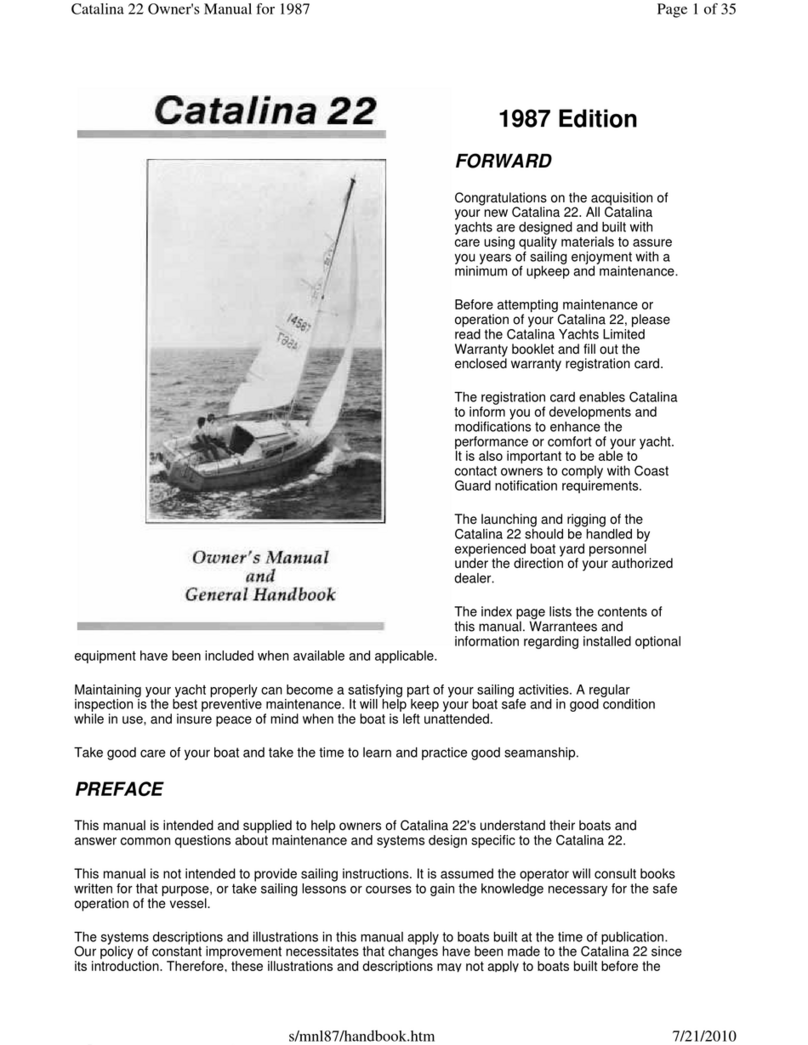
Catalina Yachts
Catalina Yachts Catalina 22 1987 Owners manual and general handbook

Yamaha
Yamaha VX WaveRunner 2007 Owner's/operator's manual

Glacier bay
Glacier bay 2013 Isle Runner 2780 owner's manual
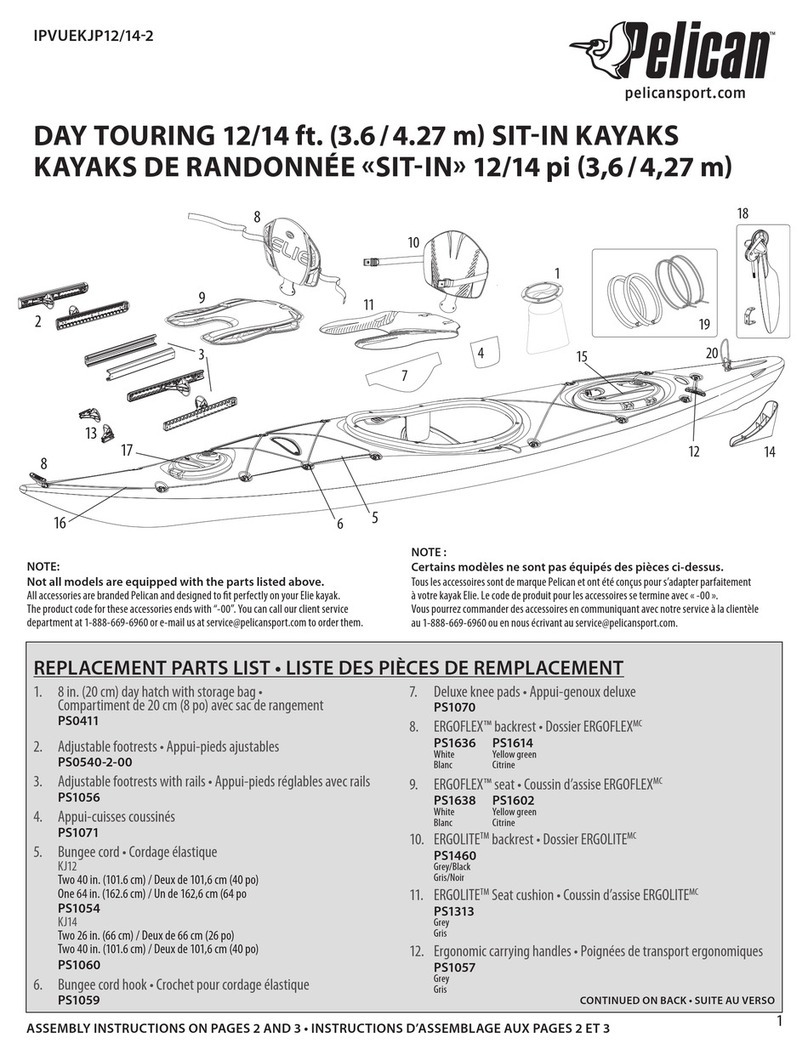
Pelican
Pelican IPVUEKJP12-2 Assembly instructions

Innova
Innova SEAWAVE owner's manual
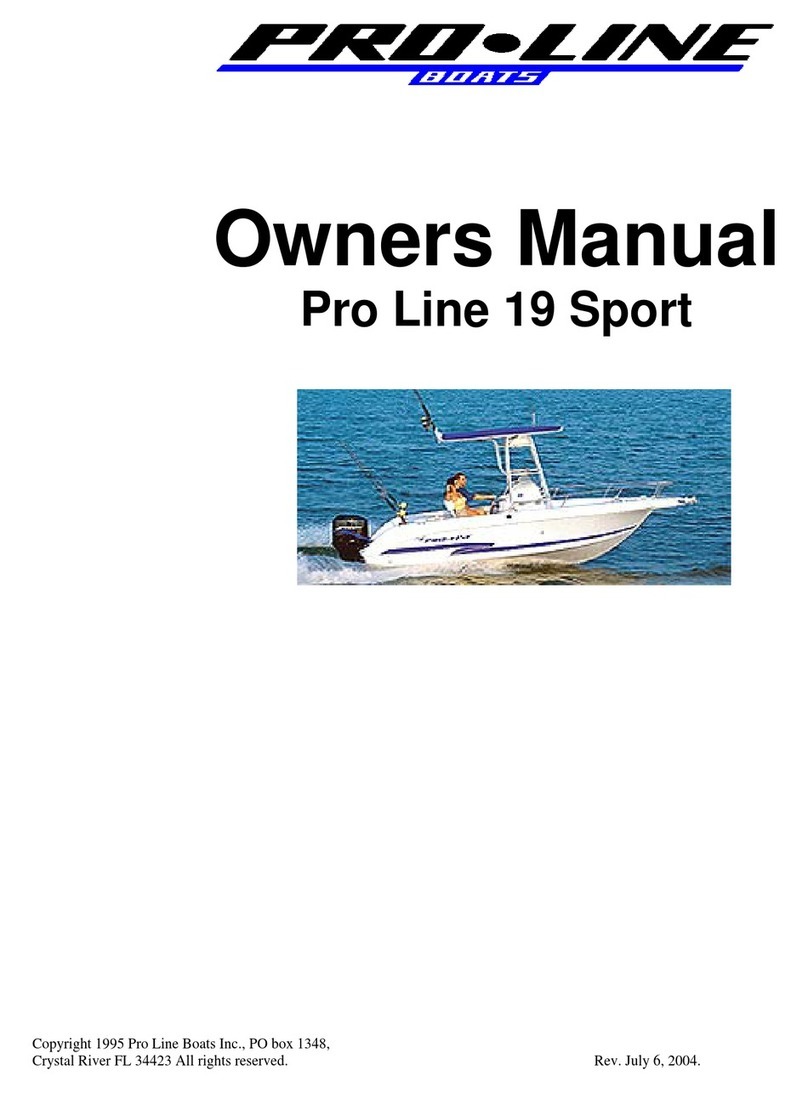
Pro-Line Boats
Pro-Line Boats Pro Line 19 Sport 2004 owner's manual

